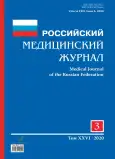Diagnostic and treatment algorithm for patients with electrical injury
- Authors: Sachkov A.V.1, Grin A.A.1, Sinkin M.V.1, Godkov M.A.1, Spiridonova T.G.1, Zhirkova E.A.1, Svetlov K.V.1, Aleynikova I.B.1, Klychnikova E.V.1, Migunov M.A.1
-
Affiliations:
- N.V. Sklifosovsky Research Institute for Emergency Medicine
- Issue: Vol 26, No 3 (2020)
- Pages: 152-160
- Section: Clinical medicine
- URL: https://journals.rcsi.science/0869-2106/article/view/48512
- DOI: https://doi.org/10.17816/0869-2106-2020-26-3-152-160
- ID: 48512
Cite item
Abstract
Determining the amount of tissue damage in electrical injury at an early stage is an extremely urgent task since the approach and therapeutic strategy depend on it to a great extent. We evaluated the informative value of various diagnostic methods, which enabled us to establish the degree and amount of tissue damage in the early stages after the electrical injury and to develop an algorithm for examining and treating the patients. The algorithm included studying the sensitive and motor function of the affected extremity and determining the creatine phosphokinase level, electroneuromyography, and stimulation neuromyography (preoperatively and intraoperatively). The algorithm allowed an accurate diagnosis of the damage and initiation of surgical treatment at an earlier stage.
Full Text
##article.viewOnOriginalSite##About the authors
Aleksey V. Sachkov
N.V. Sklifosovsky Research Institute for Emergency Medicine
Email: SachkovAV@sklif.mos.ru
MD, PhD
Russian Federation, MoscowAndrey A. Grin
N.V. Sklifosovsky Research Institute for Emergency Medicine
Email: Aagreen@yandex.ru
ORCID iD: 0000-0003-3515-8329
MD, PhD, DSc
Russian Federation, MoscowMikhail V. Sinkin
N.V. Sklifosovsky Research Institute for Emergency Medicine
Email: mvsinkin@gmail.com
ORCID iD: 0000-0001-5026-0060
MD, PhD
Russian Federation, MoscowMikhail A. Godkov
N.V. Sklifosovsky Research Institute for Emergency Medicine
Email: mgodkov@yandex.ru
ORCID iD: 0000-0001-9612-6705
MD, PhD, DSc
Russian Federation, MoscowTamara G. Spiridonova
N.V. Sklifosovsky Research Institute for Emergency Medicine
Email: SpiridonovaTG@sklif.mos.ru
ORCID iD: 0000-0001-7070-8512
MD, PhD, DSc
Russian Federation, MoscowElena A. Zhirkova
N.V. Sklifosovsky Research Institute for Emergency Medicine
Author for correspondence.
Email: ZhirkovaEA@sklif.mos.ru
ORCID iD: 0000-0002-9862-0229
MD, PhD
Russian Federation, MoscowKirill V. Svetlov
N.V. Sklifosovsky Research Institute for Emergency Medicine
Email: Svetloffkirill@yandex.ru
ORCID iD: 0000-0002-1538-0515
MD, PhD
MoscowIrina B. Aleynikova
N.V. Sklifosovsky Research Institute for Emergency Medicine
Email: Alejnikova_irina@mail.ru
ORCID iD: 0000-0003-4937-0400
MD, PhD
Russian Federation, MoscowElena V. Klychnikova
N.V. Sklifosovsky Research Institute for Emergency Medicine
Email: klychnikovaev@mail.ru
ORCID iD: 0000-0002-3349-0451
MD, PhD
Russian Federation, MoscowMikhail A. Migunov
N.V. Sklifosovsky Research Institute for Emergency Medicine
Email: mihail_migunov@mail.ru
ORCID iD: 0000-0002-2713-3634
Russian Federation, Moscow
References
- Kuznetsov V.A., Popov S.V. Electric trauma and electric burns: pathogenesis, clinic and treatment. Kombustiologiya. 2001; (7). Available at: http://combustiolog.ru/journal/e-lektrotravma-i-e-lektroozhogi-patogenez-klinika-i-lechenie (accessed 15 February 2020). (In Russ.)
- Gajbhiye A.S., Meshram M.M., Gajaralwar R.S., Kathod A.P. The management of electrical burn. Indian J Surg. 2013;75(4):278-83. doi: 10.1007/s12262-012-0476-x.
- Hedawoo J.B., Ali A. Electric burns and disability. J Indian Med Assoc. 2010;108(2):84-7.
- Tarim A., Ezer A. Electrical burn is still a major risk factor for amputations. Burns. 2013;39(2):354-7. doi: 10.1016/j.burns.2012.06.012.
- Li Q., Wang L.F., Chen Q. et al. Amputations in the burn unit: a retrospective analysis of 82 patients across 12 years. Burns. 2017;43(7): 1449-54. doi: 10.1016/j.burns.2017.04.005.
- Spiridonova T.G., Zhirkova E.A., Sachkov A.V., Frolov S.V., Lazareva E.B., Men’shikova E.D. Electrical injury: characteristics of the victims, methods of surgical treatment, microflora of wounds. Meditsinskii alfavit. 2018;3(28):59-63. (In Russ.)
- Tolstov A.V. The state of the problem of diagnosis and treatment of electrothermal burns in the Samara region. Saratovskii nauchno-medicinskii zhurnal. 2008;4(4):112-115. (In Russ.)
- Winkley J.H., Gaspard D.J., Smith L.L. Amputation as a life-saving measure in the burn patient. J Trauma. 1965;5(6):782-91. doi: 10.1097/00005373-196511000-00014.
- Ohashi M., Koizumi J., Hosoda Y. Fujishiro Y., Tuyuki A., Kikuchi K. Correlation between magnetic resonance imaging and histopathology of an amputated forearm after an electrical injury. Burns. 1998;24(4):362-8. doi: 10.1016/s0305-4179(98)00025-4.
- Kopp J., Loos B., Spilker G., Horch R.E. Correlation between serum creatinine kinase levels and extent of muscle damage in electrical burns. Burns. 2004;30(7):680-3. doi: 10.1016/j.burns.2004.05.008.
- Koumbourlis A.C. Electrical injuries. Crit Care Med. 2002;30(11 Suppl):S424-30.
- Teodoreanu R., Popescu S.A., Lascar I. Electrical injuries. Biological values measurements as a prediction factor of local evolution in electrocutions lesions. J. Med. Life. 2014;7(2):226-36.
- Hunt J., Lewis S., Parkey R., Baxter C. The use of Technetium-99m stannous pyrophosphate scintigraphy to identify muscle damage in acute electric burns. J. Trauma. 1979;19(6):409-13.
- Holliman C. J., Saffle J. R., Kravitz M., Warden G. D. Early surgical decompression in the management of electrical injuries. Am J Surg. 1982;144(6):733-9.
- Gusak V.K., Fistal’ E.Ya., Barinov E.F., Shtutin A.A. Thermal subfascial lesions. [Termicheskie subfastsial’nye porazheniya]. Donetsk; Donechchina: 2000. 240 p. (In Russ.)
- Prellwitz W., Kapp S., Neumeier D., Knedel M., Lang H. Isoenzymes of creatine kinase: distribution in the skeletal muscle and in sera of patients with muscular diseases or damages (author’s transl). Klin Wochenschr. 1978;56(11):559-65. (in German) doi: 10.1007/BF01477252.
- Nikolaev S.S. Atlas of electroneuromyography. [Atlas of electroneuromyography]. Ivanovo: PresSto; 2015. 844 p. (In Russ.)
- Preston D.C., Shapiro B. Electromyography and neuromuscular disorders. 3rd ed. Philadelphia: Saunders; 2012. 704 p. doi: 10.1016/C2010-0-68780-3.
- Shih J.G., Shahrokhi S., Jeschke M.G. Review of adult electrical burn injury outcomes worldwide: an analysis of low-voltage vs high-voltage electrical injury. J Burn Care Res. 2017;38(1):e293-e8. doi: 10.1097/BCR.0000000000000373.
- Sun C.F., Lv X.X., Li Y.J., Li W.Z., Jiang L., Li J. et al. Epidemiological studies of electrical injuries in Shaanxi province of China: a retrospective report of 383 cases. Burns. 2012;38(4):568-72. doi: 10.1016/j.burns.2011.10.012.
- Hsueh Y.Y., Chen C.L., Pan S.C. Analysis of factors influencing limb amputation in high-voltage electrically injured patients. Burns. 2011; 37(4):673-7. doi: 10.1016/j.burns.2011.01.014.
- Gille J., Schmidt T., Dragu A. Electrical injury - a dual center analysis of patient characteristics, therapeutic specifics and outcome predictors. Scand J Trauma Resusc Emerg Med. 2018;26(1):43. doi: 10.1186/s13049-018-0513-2.
- d’Amato T.A., Kaplan I.B., Britt L.D. High-voltage electrical injury: a role for mandatory exploration of deep muscle compartments. J Natl Med Assoc. 1994;86(7):535-7.
- Brandão C., Vaz M., Brito I.M., Ferreira B., Meireles R., Ramos S., Cabral L. Electrical burns: a retrospective analysis over a 10-year period. Ann Burns Fire Disasters. 2017;30(4):268-271.
Supplementary files













